Jerry L - Jan 23, 2007 6:17 pm - Voted 10/10
Lost meYou lost me at step 2. I'll just buy one I guess.
Deb - Jan 23, 2007 6:32 pm - Voted 10/10
Holy Sh!t!!Wow, what a castrophie! And to think, I just twirled the rope in a spiral to sleep on in Whitney's summit hut. Nice detailed page though.
CharlesD - Jan 23, 2007 6:51 pm - Voted 10/10
Impressive!That's very detailed. Thanks.
Strangely, this same subject is being discussed on MountainProject. There are some really impressive designs here:
http://www.mountainproject.com/v/for_sale__wanted/rugs_made_from_climbing_rope/105791075__2
rhyang - Jan 23, 2007 8:26 pm - Voted 10/10
Cool !Would you believe I was interested in such things as macrame and net-making as a kid. When I go to retire one of my ropes I am definitely going to follow these instructions :)
Matt Worster - Jan 24, 2007 2:56 pm - Hasn't voted
ExcellentOaklander just made one of these a few months ago. I was quite impressed, and a bit envious.
robojeda - Jan 24, 2007 4:03 pm - Voted 10/10
Very NiceI've got some old rope that I think is headed this direction. You got me thinking... cordolette trivet? Cheers!
MountaingirlBC - Jan 25, 2007 1:07 am - Voted 10/10
omg how cool is that?I have an old rope I'm tempted to try it with but I'm not sure if I'm mentally stable enough. Could go very very badly!
JScoles - Jan 25, 2007 3:52 pm - Hasn't voted
Re: omg how cool is that?I would be careful as well as once it get one done it becomes very very addictive.
I actually had to stop my self from trying to make mats out of the three good ropes on my rack.
I wonder if there is a "knot tyers anyomous" out there
Cheers
Nelson - Jan 26, 2007 12:11 am - Voted 10/10
Re: omg how cool is that?Back in 1974 I worked for the San Fransisco Maritime Museum and was able to get a good deal on spools of manila rope. I got into making these kind of things, and still have several of them - rugs, Turk's head picture frame, bell pulls, buttons. It was an addictive habit. I even carried some cord to work on during backpacking trips in the Sierras.
My inspiration came from The Ashley Book of Knots. My old copy is still on my bookshelf.
Great article, by the way!
zachary_dc - Jan 26, 2007 12:25 am - Hasn't voted
this is a very good ideahowever there was an article in a Rock Climbing magazine from a few years ago that showed a different style that involves no knots or weaving. All you have to do is coil the rope around itself to form a large circular rug. Then just duct tape the side you dont want showing in a few different directions, flip it over and wa la you have a large rug. Their are a few more detailed steps, but that was the jist of it. If you want the article, send me a message and i will send it to you.
Ed F - Jan 29, 2007 4:51 pm - Hasn't voted
Circular RopeIf anyone wants to do this the easy way...
Make a giant spiral out of the rope, ensuring that each spiral is really tight. Bind each rope end with metal wire and tie them off. Flip the spiral onto whatever you want to be the "bottom." Cover the entire thing with caulk - about one tube for a 50m rope. Cover the caulk with duct tape. Add non-slip stuff if desired. Viola... This method takes about 1 hour of actual labor, and a night or two to allow the caulk to dry.
menotyou - Jan 29, 2007 10:13 pm - Voted 10/10
Sewn Rope RugsRugs can also be sewn, the resulting rugs are larger (a circle has roughly a 35" diameter for a 60m rope) and flat. Sewn rugs are much more durable than the tape and glue variety. By hand expect to spend several days at 2-3hr per day. You can also send your rope into the guys at OldRopes.com and let them make it for you.
Timothy Pearl - Feb 1, 2007 9:48 pm - Voted 10/10
NiceWhat a nice winter project! Nice pics and desc. I'm gonna give it a try with some cord first for mini practice.
nurettin - Feb 9, 2007 10:51 am - Voted 10/10
GreatI thought it would be cool if I can make one but after reading the whole page I decided to save this page for my retirement.
Thanks for sharing!
IceRavines - Mar 19, 2007 1:51 pm - Voted 10/10
Great idea !I think it is a great idea. Im going to give it a shot...I have retired ropes that have become topics with fellow climbers .
UncleBob - Apr 30, 2007 3:36 pm - Voted 9/10
Geez ...So this is what happens when you're trapped inside.
Think i'll stuff one of these into my pack and ask my second to start flaking when I want to quit for the day ...
dylangroup - Nov 15, 2007 2:10 pm - Hasn't voted
dressing?i ran out of rope at the end of the knot (3 1/2 turns) and now i cant figure out fow to tighten it. the directions just say "Just start a one end and pull out the excess keeping the weave a little loose so you can feed in more turns." do i pull the 3/4 parts of the rope together? do i take the end that hadn't finnish the last turn and start yanking on it? (ropedrag!). sorry i got lost on this one but i'm afraid of messing up at this late stage. thanks to anyone that can help.
corashea - Jul 8, 2008 2:23 pm - Voted 10/10
Wow!What a great breakdown of the Turk's Head.
I've been using the much lazier (and arugably less cool looking) Prolong Knot (caution, those are PDF instructions). You can see a couple of my rugs here. I hope I can graduate to this!
chayagordon - Nov 12, 2008 7:14 pm - Hasn't voted
Tightening it down?This pattern was very easy to follow, especially compared to all the other patterns I looked at. I had some issues at a couple points in the process, but through trial and error I was able to work it out.
Now I am at the point where I have a 50 meter; 10.5 rope, woven with three turns, on a 36x36 piece of plywood with 22 screws driven into it. I can not figure out how to tighten it.
I tried taking it off the pegs, and feeding the rope through, but I wound up with rope salad, and spent a good long while getting it back ont the pegs, untangeled. Please point me in the right dierection; I am super stoked I got this far, but I am stuck.
JScoles - Nov 12, 2008 8:12 pm - Hasn't voted
Re: Tightening it down?No easy way to do it except to be very careful.
Best advice 'Take your time'
1) get it off the pegs
2) lay it flat
3) start with one end and pull about 50cms out till till starts to tightned at a trun.
4) go to that trun and do the same to the next trun
5) pass that 50cm back to the start
6) repeat until it tightens
Slow process I know but it will eventually get get there might take 4 or 5 hours though.
Like I say the pegs are far apart in the example so you can see what is going on in real life when I make one my pegs are much closer.
cheers
John Scoles



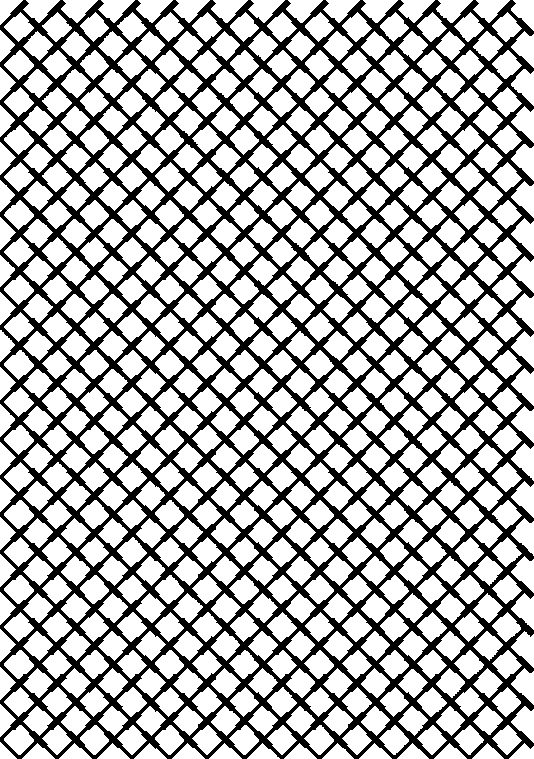
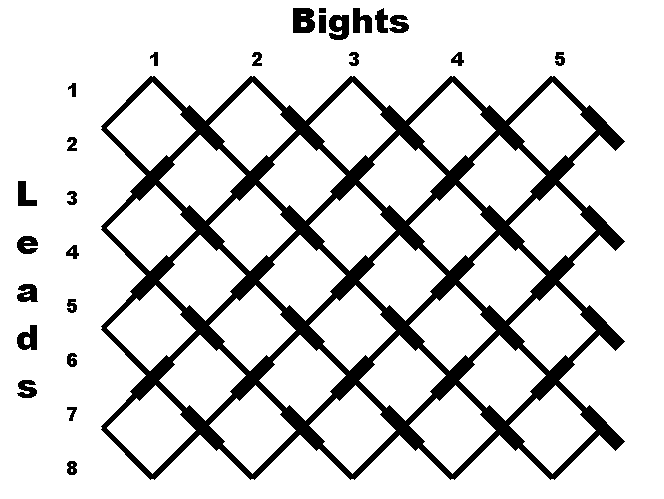


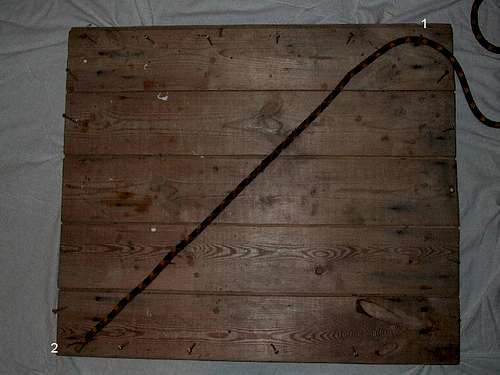

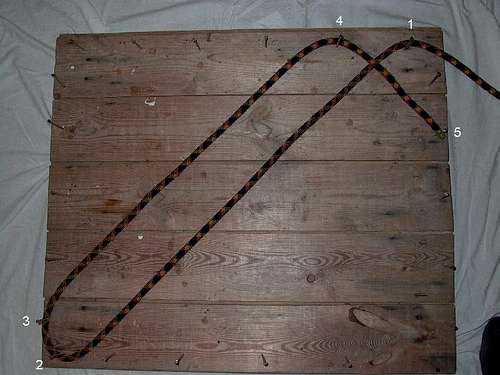
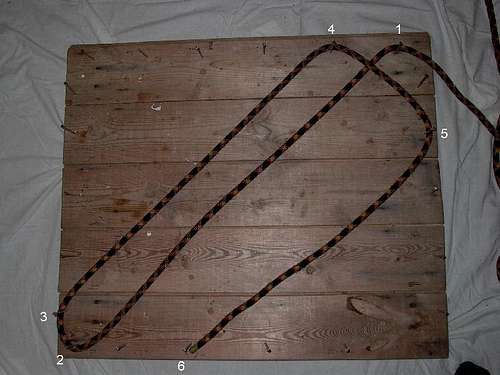






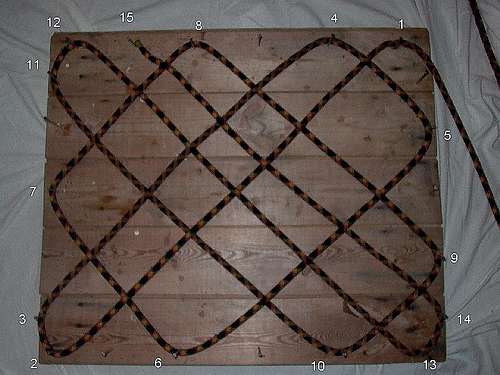
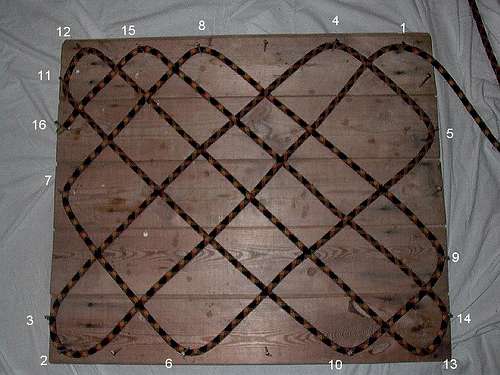
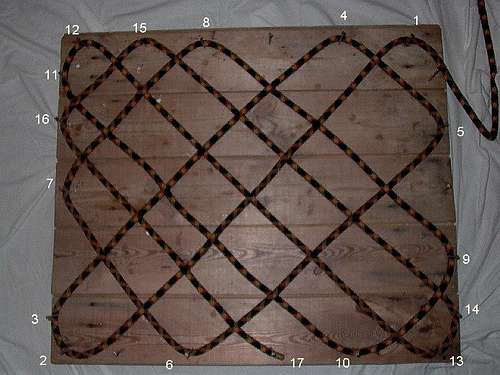
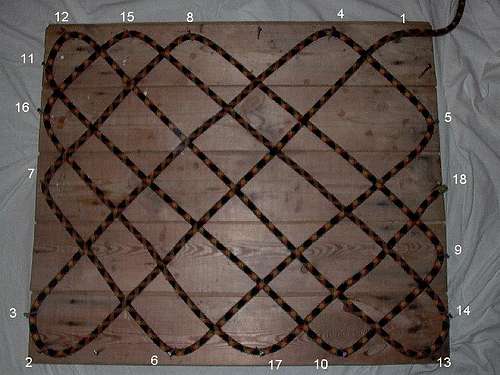




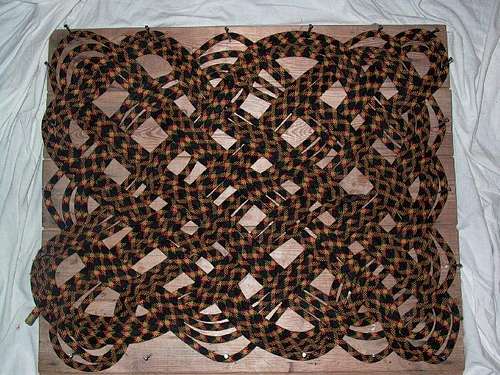



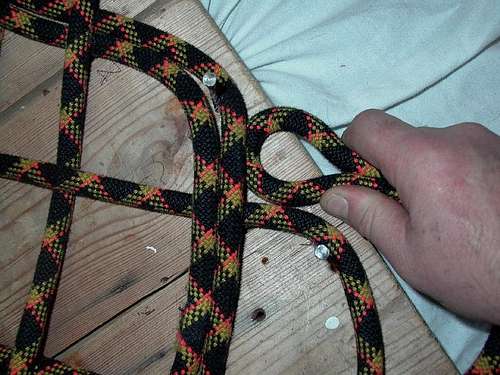















Comments
Post a Comment